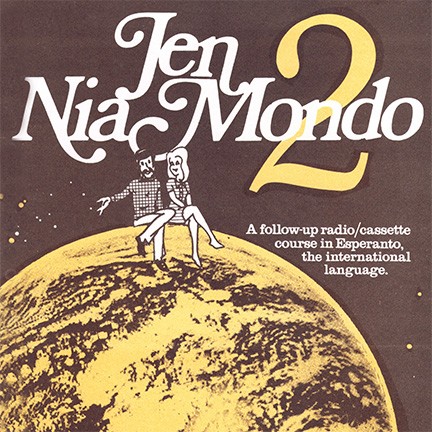
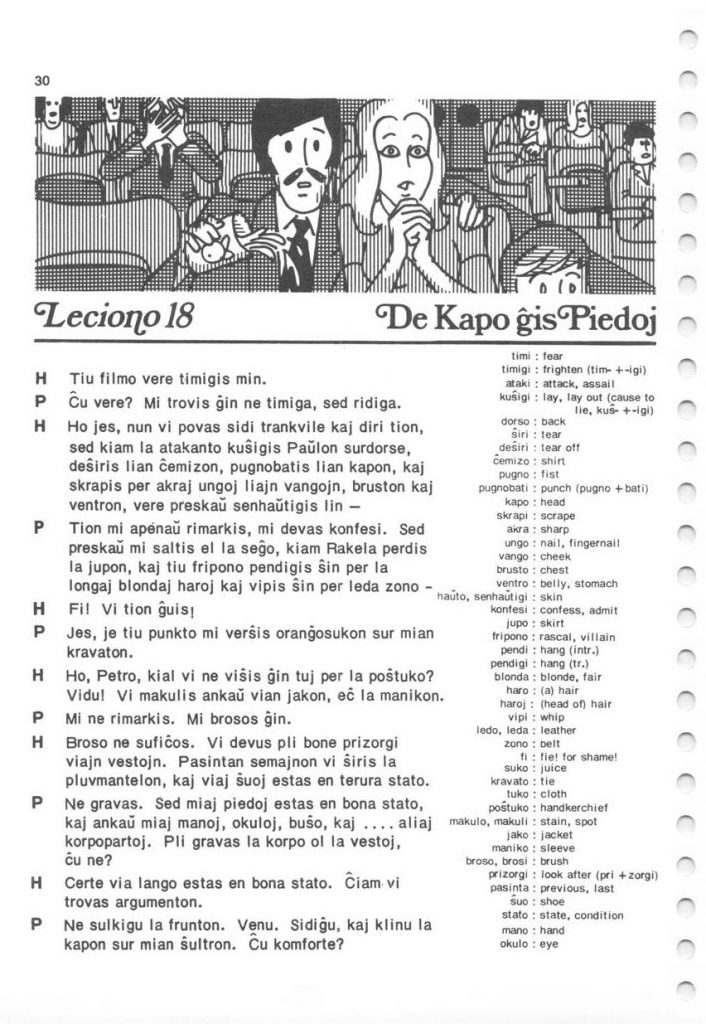
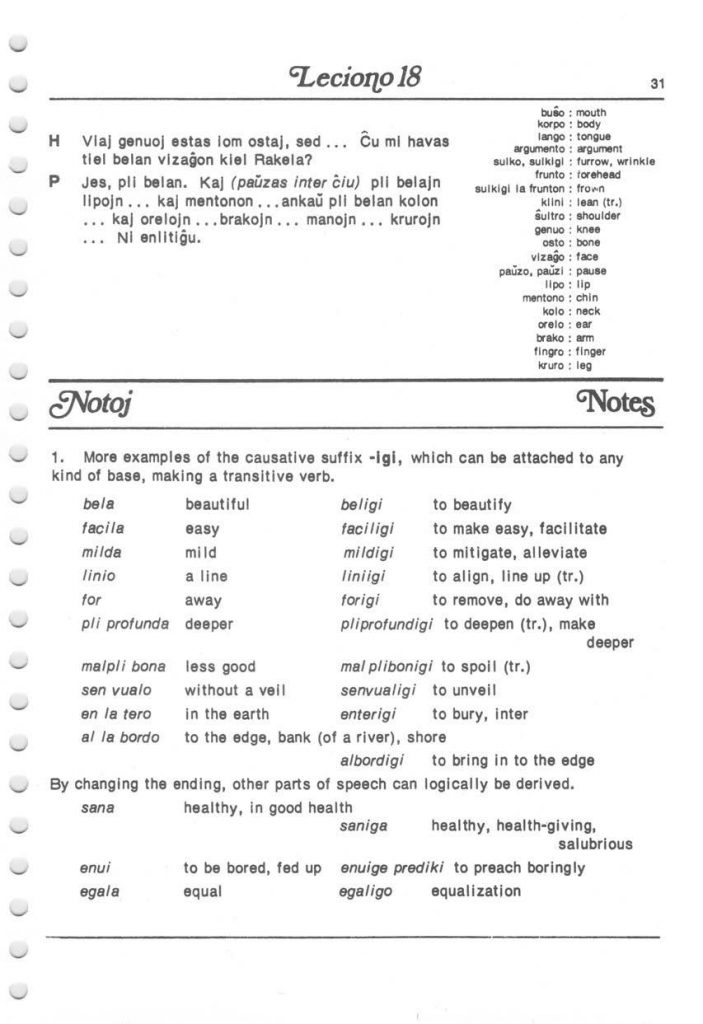
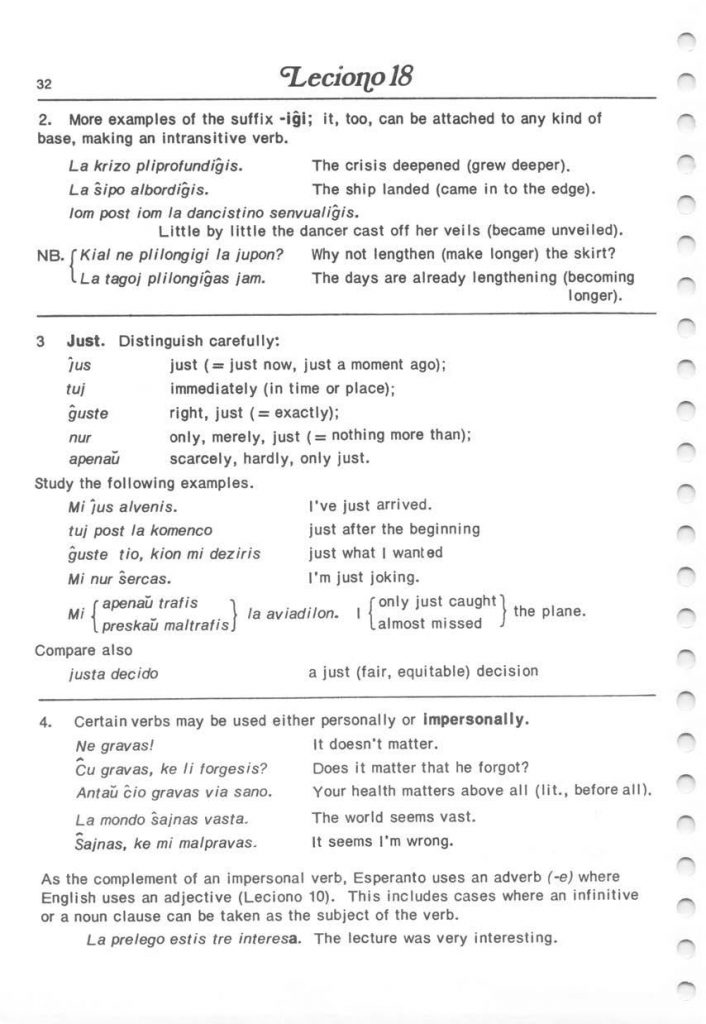
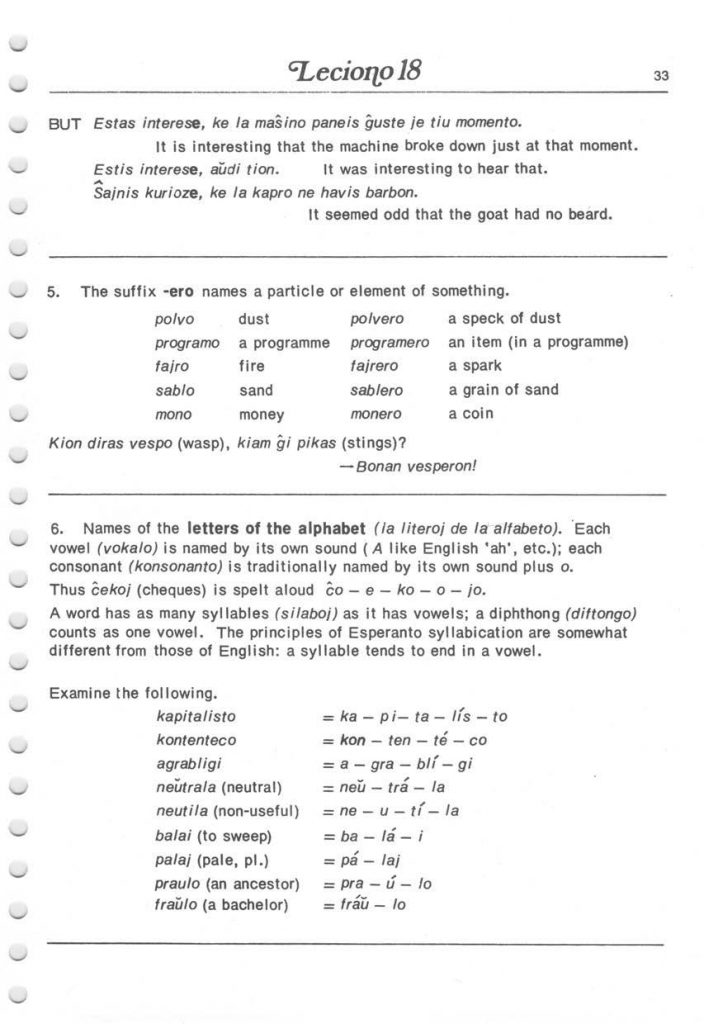
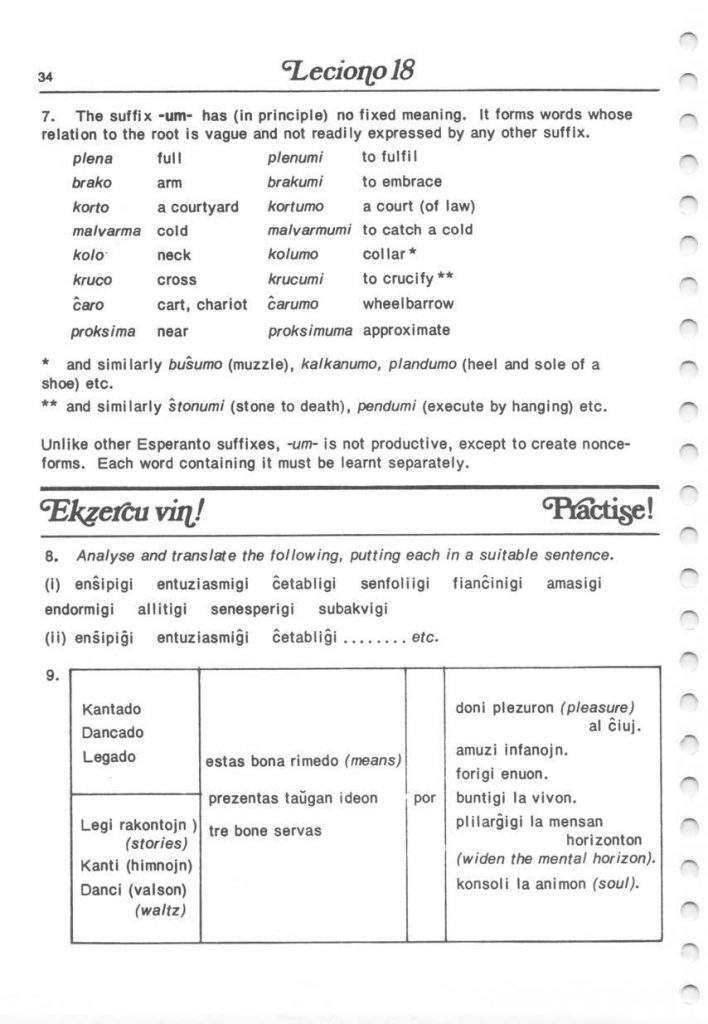
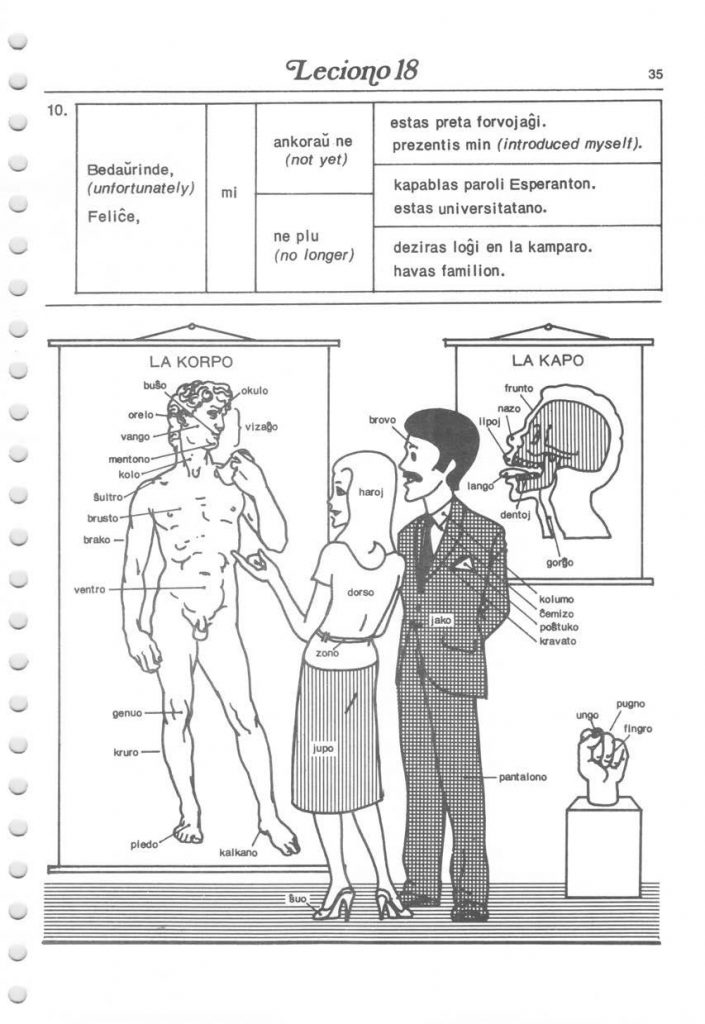
Section 11
Study the words in the picture above for different parts of the body, the head, items of clothing and the two other illustrations. Now translate and answer, in complete sentences, the following questions.
(i) On which part of the body do you find the ears?
(ii) Where is the heart (koro) inside (interne de) the body (torso)? Dekstre en la brusto? Meze en la ventro?
(iii) How many legs do you see in total (entute) in the picture?
(iv) What is the colour of Peter’s moustache (lipharoj)?
(v) Which hand is Helen using to indicate (montri al) the statue (statuo)?
(vi) Name four items of clothing Peter is wearing
(vii) Is Helen wearing a skirt, a pairs of trousers or a dress?
(viii) Write in alphabetic (alfabeta) order the words for lips, cheek, eye, nose and mouth. What is the word for this part of the head?
Section 18 Traduku

Answers are offered below
As previously you are recommended to commit as much to writing as possible. Of course what follows are only example answers, with the partial exception of the translation piece. If in doubt consult a live speaker via EAB or the app Amikumu.
Please attempt the above exercises before consulting the material below.
Lesson 18 Sample Answers
Section 8.
(i) enŝipigi – to load x onto the ship
La ŝipanaro enŝipigis la kamionojn kaj tial la ŝipo nun estas preta por iri al Skotlando.
The ship’s crew put the lorries on board and so the ship is ready now to go to Scotland.
(ii) entuziasmigi – to enthuse x about something
La instruistino kondukis grupon da infanoj al la arbaro por vidi birdojn kaj entuziasmigi ilin pri la naturo.
(iii) ĉetabligi – to cause / bring x to the table
La patrino frapis la gongon por ke la edzo ĉetabligu la infanojn
(iv) senfoliigi – to cause x to be without leaves
La ventego estis tiel forta ke ĝi senfoliigis multajn arbojn
(v) fianĉinigi – to take x as an intended wife
Post la virino konsentis esti lia edzino, li aĉetis belan ringon por fianĉinigi ŝin.
(vi) amasigi – to cause x to crowd / amass together
La futbal-matĉo amasigis la fanojn (adorantojn) veni al la ekscita evento.
(vii) endormigi – to make x fall asleep
La patro legis interesan rakonton al la infanoj por endormigi ilin.
(viii) allitigi – someone put x to bed
La patrino allitigis la infanojn ĉar estis sufiĉe malfrue.
(ix) senesperigi – to cause x to be without hope
La kirurgo senesperigis la virinon pro malbona novaĵo pri ŝia kancero.
(x) subakvigi – to cause x to be submerged in the water
La malamika ŝipo pafis torpedojn por subakvigi multajn batalŝipojn dum la milito.
Section 9
Kantado tre bone servas por doni plezuron al ĉiuj – Singing is a good way of giving pleasure to everyone
Dancado estas bona rimedo por forigi enuon – Dancing is a good remedy for dealing with boredom
Legado prezentas taŭgan ideon por plilarĝigi la mensan horizonton – Reading shows an appropriate idea for widening the mental level
Legi rakontojn tre bone servas por amuzi infanojn – Reading books is an excellent way of amusing children
Kanti tre bone servas por konsoli la animon – Singing hymns is a good way of comforting the soul
Danci valson estas bona rimedo por buntigi la vivon – Dancing a waltz is a good remedy for bringing variety to life
Section 10
Bedaŭrinde mi ankoraŭ ne havas familion – Unfortunately I still do not have a family
Bedaŭrinde mi ankoraŭ ne kapablas paroli Esperanton – Unfortunately I still can’t speak Esperanto
Bedaŭrinde mi ankoraŭ ne prezentis min – Unfortunately I did not introduce myself yet
Feliĉe mi ne plu estas preta forvojaĝi – Happily I am no longer ready to go travelling
Bedaŭrinde mi ne plu estas universitatano – Unfortunately I am no longer a member of the university
Feliĉe mi ne plu deziras loĝi en la kamparo – Fortunately I no longer want to live in the countryside
Section 11
Study the words for the parts of the body, the head and items of clothing, Now translate and answer, in complete sentences, the following questions.
(i) On which part of the body do you find the ears? – Sur kiu parto de la korpo vi trovas la orelojn? – Oni trovas la orelojn ĉe la kapo.
(ii) Where is the heart (koro) inside (interne de) the body (torso) In the right in the chest ? In the middle in the belly? – Kie estas la koro interne de la torso? – La koro estas dekstre interne de la brusto.
(iii) How many legs do you see in the picture? – Kiom da kruroj vi povas vidi en la bildo? – Mi povas vidi ses krurojn en la bildo.
(iv) What is the colour of Peter’s moustache (lipharoj)? – Kiun koloron havas la lipharoj de Petro? – La lipharoj de Petro havas nigran koloron.
(v) Which hand is Helen using to indicate the statue? Kiun manon uzas Helena por montri al la statuo? – Helena uzas la maldekstran manon por montri al la statuo.
(vi) Name three items of clothing Peter is wearing. Nomu kvar pecojn da vestoj kiujn portas Petro. Petro portas jakon, kravaton, ĉemizon kaj pantalonon.
(vii) Is Helen wearing a skirt, trousers or a frock (robo)? Ĉu Helena portas jupon, pantalonon aŭ robon? Helena portas jupon.
(viii) Write in alphabetic (alfabeta) order the words for lips, cheek, eyes, nose and mouth. . What is the word for this part of the head? – Skribu alfabete la vortojn por lipoj, vango, okuloj kaj buŝo. Jen ili – buŝo, lipoj, nazo, okuloj, vango! What is the word for this part of the head? Kio estas la vorto por ĉi tiu parto de la kapo? La vorto por ĉi tiu parto de la kapo estas vizaĝo.
Lesson 18 : Vocabulary
Akr/a
Al/bord/iĝ/i
Alfabet/o
Anim/o
Apenaŭ
Argument/o
Atak/i
Bedaŭr/i
Bedaur/ind/e
Bel/ig/i
Blond/a
Bord/o
Brak/o
Brak/um/i
Bros/i
Bros/o
Brust/o
Buŝ/o
Ĉar/o
Ĉar/um/o
Ĉeĥ/o
Ĉek/o
Ĉemiz/o
Deŝir/I
Diftong/o
Dors/o
En/tut/e
Er/o
Fajr/o
Fajr/er/o
Fi!
Fingr/o
For/ig/i
Fraŭl/o
Fripon/o
Frunt/o
Genu/o
Ĝust/e
Har/o
Har/o/j
Haŭt/o
Himn/o
Interne de
Horizont/o
Jak/o
Jup/o
Ĵus
Kalkano
Kalkan/um/o
Kap/o
Kapital/o
Kapital/ism/o
Klin/i tr
Kol/o
Kol/um/o
Konfes/i
Konsonant/o
Koro
Korp/o
Kort/um/o
Kravat/o
Krur/o
Kuŝ/ig/i
Lang/o
Larĝa
Led/o
Lip/o
Lipharoj
Liter/o
Makul/I
Makul/o
Man/o
Manik/o
Menton/o
Mens/o
Mens/a
Mon/er/o
Neŭtral/a
Okul/o
Orel/o
Ost/o
Pantalono
Pas/i ntr
Pas/int/a
Paŭz/i
Paŭz/o
Pend/i ntr
Pend/ig/i tr
Pend/um/i
Pik/i
Pland/o
Pland/um/o
Plen/um/i
Plezur/o
Pli/long/ig/i
Polv/o
Polv/er/o
Poŝ/tuk/o
Pra/ul/o
Preleg/o -/i
Pret/a
Prezent/i
Pri/zorg/I
Profund/a
Program/er/o
Proksim/a
Proksim/um/e
Pugn/o
Pugn/o/bat/i
Rakont/o
Rimed/o
Robo
Sabl/er/o
Sen/haŭt/ig/i
Silab/o
Skrap/i
Stat/o
Statu/o
Suk/o
Sulk/ig/i
Sulk/o
Sulk/ig/i
Ŝir/i
Ŝu/o
Ŝultr/o
Tim/i
Tim/igi
Torso
Tuk/o
Ung/o
Um/o
Vals/o
Vang/o
Vast/a
Ventr/o
Vip/i
Vizaĝ/o
Vokal/o
Vual/o
Zon/o/
Sharp
Land, berth
Alphabet
Soul
Scarcely, only just
Argument
Attack, assail
Regret, be sorry
Unfortunately
Make beautiful
Blonde, fair
Bank, shore
Arm
Embrace, cuddle
Brush vb
Brush n
Chest (of body)
Mouth cf Fr bouche
Chariot; cart
Wheelbarrow
Czech
Cheque
Shirt
Tear off
Diphthong
Back cf dorsal
In total
Element, particle
Fire
Spark (of fire)
Fie, for shame
Finger
Remove, do away with
Bachelor
Rascal, villain
Forehead
Knee cf genuflex
Precisely, exactly right
Hair (single hair)
(Head of) hair
Skin
Hymn
Inside
Horizon
Jacket
Skirt
Just now
Heel (body)
Heel (shoe)
Head (of body)
Capital (money)
Capitalism
Lean, tilt
Neck (of body)
Collar
Confess, admit
Consonant
Heart
Body
Law court
Tie, necktie
Leg
Lay, cause to lie
Tongue (of body)
Broad, wide
Leather
Lip
Moustache
Letter (alphabet)
Stain cf immaculate
Stain, spot
Hand (of body)
Sleeve
Chin
Mind
Mental
Coin
Neutral
Eye
Ear
Bone cf ossify
Trousers, pants
Pass, pass through
Previous, past, last
Pause, take a break
Pause
Hang, hang down
Make hang, suspend
execute by hanging
Sting
Sole (of foot)
Sole (of shoe)
Fulfil, accomplish
Pleasure
Lengthen
Dust
Speck of dust
Hankie, nose cloth
Ancestor
Lecture
Ready
Introduce
Look after
Deep; profound
Item in program
Near, nearby
Approximately
Fist cf pugnacious
Punch
Story
Means, resource
Dress
Grain of sand
Skin
Syllable
Scrape
State, condition
Statue
Juice cf succulent
Wrinkle
Furrow
Furrow (vb)
Tear
Shoe
Shoulder (of body)
Fear cf timid
Frighten
Torso
Cloth
Nail, fingernail
Thingummyjig
Waltz
Cheek
Spacious, vast
Belly, paunch
Whip
Face
Vowel
Veil
Belt, zone